1.工作流
1.1 开发前奏
介绍
当前系统activit开发以springboot+mybatis开发为准,
1.1.1 IDEA安装actiBPM
通过File -> Settings -> Plugins 找到actiBPM插件进行安装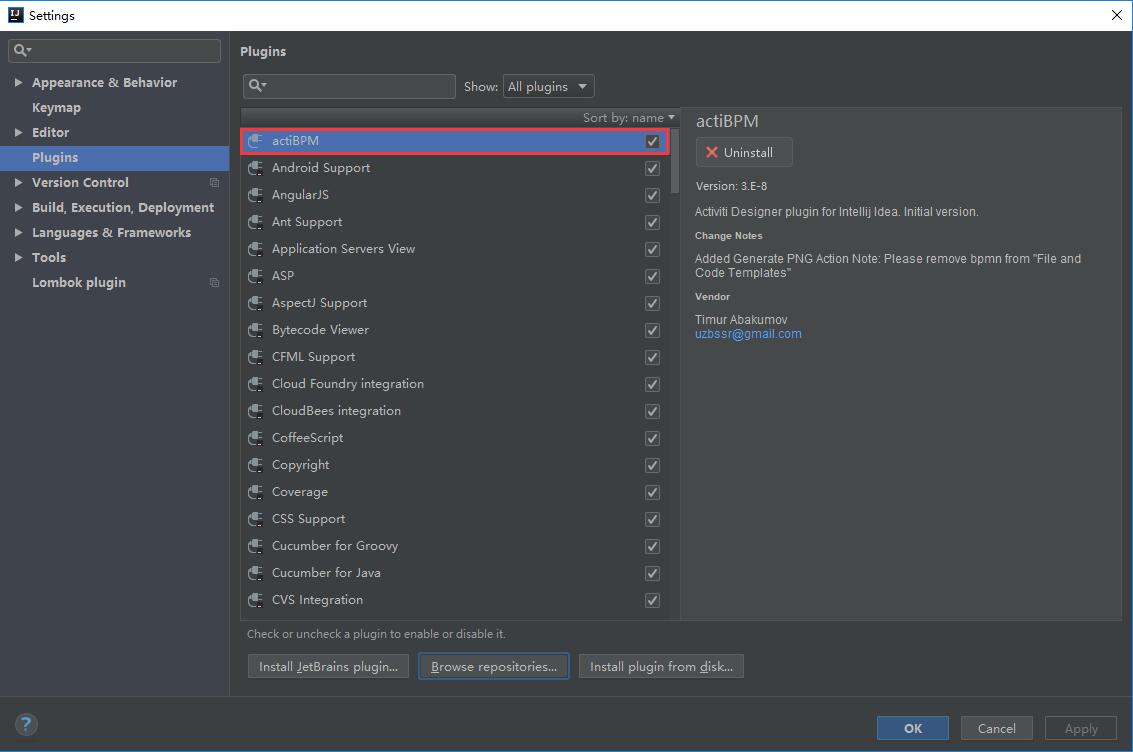
1.1.2 核心API介绍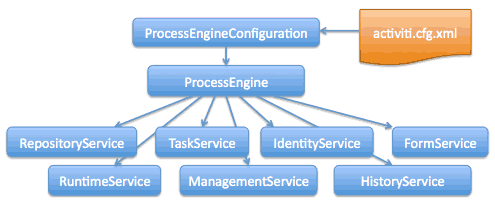
ProcessEngineConfiguration:流程引擎配置。
ProcessEngine:流程引擎
核心七大接口
RepositoryService:提供一系列管理流程部署和流程定义的API。
RuntimeService:在流程运行时对流程实例进行管理与控制。
TaskService:对流程任务进行管理,例如任务提醒、任务完成和创建任务等。
IdentityService:提供对流程角色数据进行管理的API,这些角色数据包括用户组、用户及它们之间的关系。
ManagementService:提供对流程引擎进行管理和维护的服务,提供对activiti数据库的直接访问【一般不用】
HistoryService:对流程的历史数据进行操作,包括查询、删除这些历史数据。FormService:表单服务
1.1.3 添加依赖 pom.xml
<dependency>
<groupId>org.activiti</groupId>
<artifactId>activiti-spring-boot-starter-basic</artifactId>
<version>6.0.0</version>
</dependency>
1.1.4 yml配置
spring:
activiti:
check-process-definitions: true #自动检查、部署流程定义文件
database-schema-update: true #自动更新数据库结构
history-level: full #保存历史数据级别设置为full最高级别,便于历史数据的追溯
# process-definition-location-prefix: classpath:/processes/ #流程定义文件存放目录
#process-definition-location-suffixes: #流程文件格式
# - **.bpmn20.xml
# - **.bpmn
springboot环境下不再以activiti.cfg.xml文件的形式配置,activiti使用starter配置后属于spring下,所以在yml里配置。
- check-process-definitions【检查Activiti数据表是否存在及版本号是否匹配】默认为true,自动创建好表之后设为false。设为false会取消自动部署功能。
-
database-schema-update【在流程引擎启动和关闭时处理数据库模式】如下四个值:
- false (默认值):在创建流程引擎时检查库模式的版本,如果版本不匹配则抛出异常。
- true:在创建流程引擎时,执行检查并在必要时对数据库中所有的表进行更新,如果表不存在,则自动创建。 、
- create-drop:在创建流程引擎时,会创建数据库的表,并在关闭流程引擎时删除数据库的表。
- drop-create:Activiti启动时,执行数据库表的删除操作,在Activiti关闭时,会执行数据库表的创建操作。
-
history-level 【历史数据保存级别】
- none:不保存任何的历史数据,因此,在流程执行过程中,这是最高效的。
- activity:级别高于none,保存流程实例与流程行为,其他数据不保存。
- audit:除activity级别会保存的数据外,还会保存全部的流程任务及其属性。audit为history的默认值。
- full:保存历史数据的最高级别,除了会保存audit级别的数据外,还会保存其他全部流程相关的细节数据,包括一些流程参数等。
1.1.5 添加processes目录
SpringBoot集成activiti默认会从classpath下的processes目录下读取流程定义文件,所以需要在src/main/resources目录下添加processes目录,并在目录中创建流程文件.
如果没有processes目录,则需要修改配置spring.activiti.process-definition-location-prefix,指定流程文件存放目录。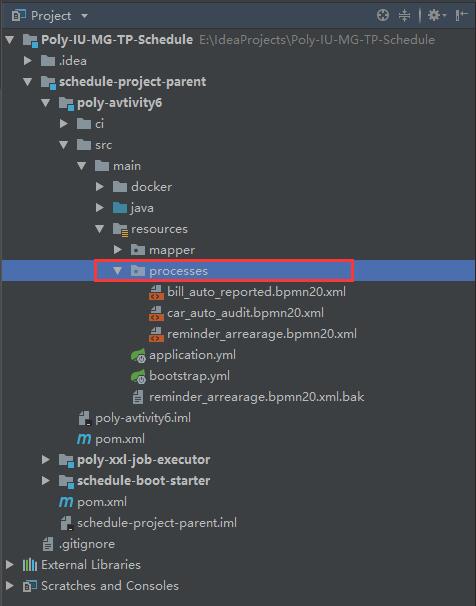
1.1.6 其他相关配置
-
现在系统的启动类排除org.activiti.spring.boot.SecurityAutoConfiguration即可
@SpringBootApplication(exclude = SecurityAutoConfiguration.class,scanBasePackages="com.poly")
public class AvtivityApplication {public static void main(String[] args) { SpringApplication.run(AvtivityApplication.class, args); }}
-
官方文档给出的启动类配置
@Configuration
@ComponentScan
@EnableAutoConfiguration
public class MyApplication {public static void main(String[] args) { SpringApplication.run(MyApplication.class, args); }}
1.1.7 配置bpmn
- 通过插件配置
-
官方文档测试bpmn文件 命名为one-task-process.bpmn20.xml 放入processes目录
<?xml version="1.0" encoding="UTF-8"?> <definitions xmlns="http://www.omg.org/spec/BPMN/20100524/MODEL" xmlns:activiti="http://activiti.org/bpmn" targetNamespace="Examples"> <process id="oneTaskProcess" name="The One Task Process"> <startEvent id="theStart" /> <sequenceFlow id="flow1" sourceRef="theStart" targetRef="theTask" /> <userTask id="theTask" name="my task" /> <sequenceFlow id="flow2" sourceRef="theTask" targetRef="theEnd" /> <endEvent id="theEnd" /> </process> </definitions>
1.1.8 配置数据源
注意mysql连接池版本
# com.mysql.cj.jdbc.Driver
spring:
datasource:
driver-class-name: com.mysql.cj.jdbc.Driver
url: jdbc:mysql://127.0.0.1:3306/activiti_test?useUnicode=true&characterEncoding=UTF-8&serverTimezone=UTC
username: root
password: 12345678
1.2 表介绍
在1.1.2~1.1.8完成后 启动项目会生成如下表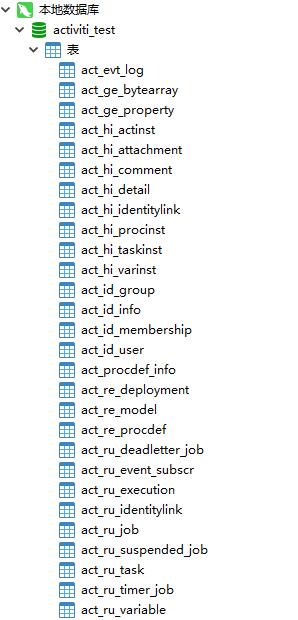
- act_ge_ 通用数据表,ge是general的缩写
- act_hi_ 历史数据表,hi是history的缩写,对应HistoryService接口
- act_id_ 身份数据表,id是identity的缩写,对应IdentityService接口
- act_re_ 流程存储表,re是repository的缩写,对应RepositoryService接口,存储流程部署和流程定义等静态数据
-
act_ru_ 运行时数据表,ru是runtime的缩写,对应RuntimeService接口和TaskService接口,存储流程实例和用户任务等动态数据
资源库流程规则表 1) act_re_deployment 部署信息表 2) act_re_model 流程设计模型部署表 3) act_re_procdef 流程定义数据表 运行时数据库表 1) act_ru_execution运行时流程执行实例表 2) act_ru_identitylink运行时流程人员表,主要存储任务节点与参与者的相关信息 3) act_ru_task运行时任务节点表 4) act_ru_variable运行时流程变量数据表 历史数据库表 1) act_hi_actinst 历史节点表 2) act_hi_attachment历史附件表 3) act_hi_comment历史意见表 4) act_hi_identitylink历史流程人员表 5) act_hi_detail历史详情表,提供历史变量的查询 6) act_hi_procinst历史流程实例表 7) act_hi_taskinst历史任务实例表 8) act_hi_varinst历史变量表 组织机构表 1) act_id_group用户组信息表 2) act_id_info用户扩展信息表 3) act_id_membership用户与用户组对应信息表 4) act_id_user用户信息表
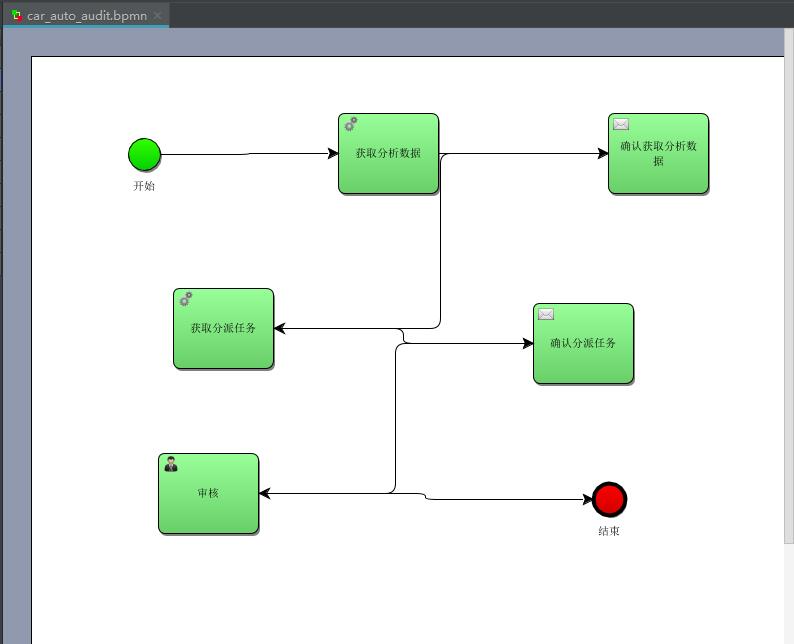
1.3 开发实例
1.3.1 项目开发案例
- 通过actiBPM设置流程
在processes下建立bpmn流程,之后更改为bpmn20.xml格式(注:具体xml内容请看项目中processes文件)
1.3.2 个人实例
思路
- 员工请假,先创建请假流程
- 员工填写请假申请,也可以不填写,直接结束流程
- 提交给直接主管审批,如果直接主管拒绝,则重新填写,如果直接主管同意,再到部门主管审批,
- 部门主管审批部门主管同意,则请假流程结束,请假成功,如果部门主管不同意,返回员工重新提交申请。
- 创建流程文件
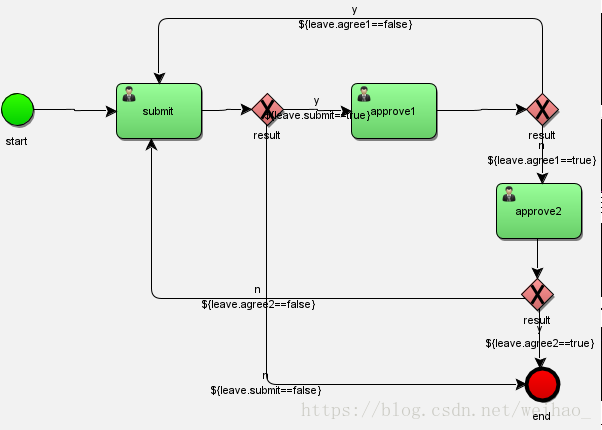
代码
<?xml version="1.0" encoding="UTF-8" standalone="yes"?>
<definitions xmlns="http://www.omg.org/spec/BPMN/20100524/MODEL" xmlns:activiti="http://activiti.org/bpmn" xmlns:bpmndi="http://www.omg.org/spec/BPMN/20100524/DI" xmlns:dc="http://www.omg.org/spec/DD/20100524/DC" xmlns:di="http://www.omg.org/spec/DD/20100524/DI" xmlns:tns="http://www.activiti.org/testm1539766523202" xmlns:xsd="http://www.w3.org/2001/XMLSchema" xmlns:xsi="http://www.w3.org/2001/XMLSchema-instance" expressionLanguage="http://www.w3.org/1999/XPath" id="m1539766523202" name="" targetNamespace="http://www.activiti.org/testm1539766523202" typeLanguage="http://www.w3.org/2001/XMLSchema">
<process id="leave1" isClosed="false" isExecutable="true" processType="None">
<startEvent id="_2" name="start"/>
<userTask activiti:assignee="${leave.userId}" activiti:exclusive="true" id="_3" name="submit"/>
<exclusiveGateway gatewayDirection="Unspecified" id="_4" name="result"/>
<userTask activiti:assignee="${leave.approver1}" activiti:exclusive="true" id="_5" name="approve1"/>
<exclusiveGateway gatewayDirection="Unspecified" id="_6" name="result"/>
<userTask activiti:assignee="${leave.approver2}" activiti:exclusive="true" id="_7" name="approve2"/>
<exclusiveGateway gatewayDirection="Unspecified" id="_8" name="result"/>
<endEvent id="_9" name="end"/>
<sequenceFlow id="_10" sourceRef="_2" targetRef="_3"/>
<sequenceFlow id="_11" sourceRef="_3" targetRef="_4"/>
<sequenceFlow id="_12" name="y" sourceRef="_4" targetRef="_5">
<conditionExpression xsi:type="tFormalExpression"><![CDATA[${leave.submit==true}]]></conditionExpression>
</sequenceFlow>
<sequenceFlow id="_13" name="n" sourceRef="_4" targetRef="_9">
<conditionExpression xsi:type="tFormalExpression"><![CDATA[${leave.submit==false}]]></conditionExpression>
</sequenceFlow>
<sequenceFlow id="_14" sourceRef="_5" targetRef="_6"/>
<sequenceFlow id="_15" name="n" sourceRef="_6" targetRef="_7">
<conditionExpression xsi:type="tFormalExpression"><![CDATA[${leave.agree1==true}]]></conditionExpression>
</sequenceFlow>
<sequenceFlow id="_16" sourceRef="_7" targetRef="_8"/>
<sequenceFlow id="_17" name="y" sourceRef="_6" targetRef="_3">
<conditionExpression xsi:type="tFormalExpression"><![CDATA[${leave.agree1==false}]]></conditionExpression>
</sequenceFlow>
<sequenceFlow id="_18" name="n" sourceRef="_8" targetRef="_3">
<conditionExpression xsi:type="tFormalExpression"><![CDATA[${leave.agree2==false}]]></conditionExpression>
</sequenceFlow>
<sequenceFlow id="_19" name="y" sourceRef="_8" targetRef="_9">
<conditionExpression xsi:type="tFormalExpression"><![CDATA[${leave.agree2==true}]]></conditionExpression>
</sequenceFlow>
</process>
</definitions>
-
编写接口
@RestController
@RequestMapping("/level/v1")
public class LeaveController {public static final Logger log = LoggerFactory.getLogger(LeaveController.class); @Autowired private RuntimeService runtimeService; @Autowired private TaskService taskService; @Autowired private ProcessEngine processEngine; /** * 启动流程 * @param userId * @return */ @RequestMapping(value = "/start", method = RequestMethod.GET) public Map<String, Object> start(@RequestParam String userId){ Map<String, Object> vars = new HashMap<>(); Leave leave = new Leave(); leave.setUserId(userId); vars.put("leave",leave); ProcessInstance processInstance = runtimeService.startProcessInstanceByKey("leave1",vars); Map<String, Object> resultMap = new HashMap<>(); return resultMap; } /** * 填写请假单 * @param leave * @return */ @RequestMapping(value="/apply", method = RequestMethod.POST) public Map<String, Object> apply(@RequestBody Leave leave){ Task task = taskService.createTaskQuery().taskId(leave.getTaskId()).singleResult(); Map<String, Object> vars = new HashMap<>(); Leave origin = (Leave) taskService.getVariable(leave.getTaskId(), "leave"); origin.setDesc(leave.getDesc()); origin.setStartDate(leave.getStartDate()); origin.setEndDate(leave.getEndDate()); origin.setTotalDay(leave.getTotalDay()); origin.setApprover1(leave.getApprover1()); origin.setApprover2(leave.getApprover2()); origin.setSubmit(leave.getSubmit()); vars.put("leave", origin); taskService.complete(leave.getTaskId(), vars); Map<String, Object> resultMap = ResultMapHelper.getSuccessMap(); return resultMap; } /** * 查询用户流程 * @param userId * @return */ @RequestMapping(value = "/find", method = RequestMethod.GET) public Map<String, Object> find(@RequestParam("userId")String userId){ List<Task> taskList = taskService.createTaskQuery().taskAssignee(userId).list(); List<Leave> resultList = new ArrayList<>(); if(!CollectionUtils.isEmpty(taskList)){ for(Task task : taskList){ Leave leave = (Leave) taskService.getVariable(task.getId(),"leave"); leave.setTaskId(task.getId()); leave.setTaskName(task.getName()); resultList.add(leave); } } Map<String, Object> resultMap = ResultMapHelper.getSuccessMap(); resultMap.put("datas", resultList); return resultMap; } /** * 直接主管审批 * @param leave * @return */ @RequestMapping(value = "/approve1", method = RequestMethod.POST) public Map<String, Object> approve1(@RequestBody Leave leave){ Task task = taskService.createTaskQuery().taskId(leave.getTaskId()).singleResult(); Map<String, Object> vars = new HashMap<>(); Leave origin = (Leave) taskService.getVariable(leave.getTaskId(), "leave"); origin.setApproveDesc1(leave.getApproveDesc1()); origin.setAgree1(leave.getAgree1()); vars.put("leave", origin); taskService.complete(leave.getTaskId(),vars); Map<String, Object> resultMap = ResultMapHelper.getSuccessMap(); return resultMap; } /** * 部门主管审批 * @param leave * @return */ @RequestMapping(value = "/approve2", method = RequestMethod.POST) public Map<String, Object> approve2(@RequestBody Leave leave){ Task task = taskService.createTaskQuery().taskId(leave.getTaskId()).singleResult(); Map<String, Object> vars = new HashMap<>(); Leave origin = (Leave) taskService.getVariable(leave.getTaskId(), "leave"); origin.setApproveDesc2(leave.getApproveDesc2()); origin.setAgree2(leave.getAgree2()); vars.put("leave", origin); taskService.complete(leave.getTaskId(),vars); Map<String, Object> resultMap = ResultMapHelper.getSuccessMap(); return resultMap; } /** * 查看历史记录 * @param userId * @return */ @RequestMapping(value="/findClosed", method = RequestMethod.GET) public Map<String, Object> findClosed(String userId){ HistoryService historyService = processEngine.getHistoryService(); List<HistoricProcessInstance> list = historyService.createHistoricProcessInstanceQuery().processDefinitionKey("leave1").variableValueEquals("leave.userId",userId).list(); List<Leave> leaves = new ArrayList<>(); for(HistoricProcessInstance pi : list){ leaves.add((Leave) pi.getProcessVariables().get("leave")); } Map<String, Object> resultMap = ResultMapHelper.getSuccessMap(); resultMap.put("datas", leaves); return resultMap; }}
public class Leave implements Serializable {
private static final long serialVersionUID = 2248469053125414262L;
private String userId;
private Boolean submit;
private Date startDate;
private Date endDate;
private float totalDay;
private String desc;
private String taskId;
private String taskName;
private String approver1;
private Boolean agree1;
private String approveDesc1;
private String approver2;
private Boolean agree2;
private String approveDesc2;
}









